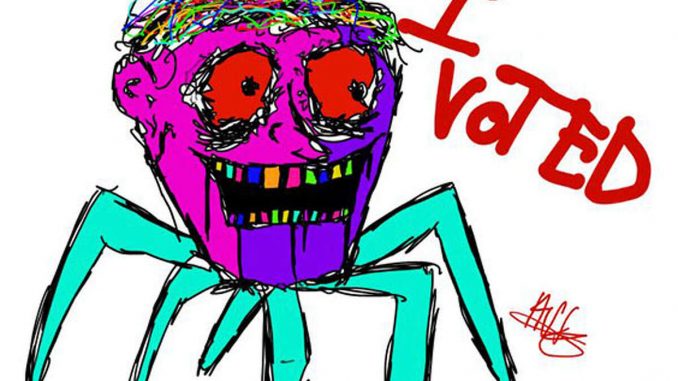
At approximately 3 p.m. on Tuesday, Nov. 8, the line to vote at the SUNY New Paltz multipurpose room for the midterm elections was wrapped around the second floor and continued down the stairs. While students and faculty members waited in line, they scrolled through their social media accounts. As they looked at their friends’ posts, which are usually curated of selfies and pictures of food, instead they saw the same image repeated over and over again: a creepy, bright pink spider with jagged teal legs, multicolor teeth and the words “I VOTED” scribbled on the top.
An unusual drawing, yet it won the Ulster County 2nd Annual “I Voted” Sticker Contest. Prior to its official release, the spider had crawled its way across social media, finding virality in July as the contest’s submission-voting deadline drew to a close. Its creator, 14 year old Ulster County resident Hudson Rowan has made multiple statements to the press claiming that there is no deeper message to the ominous creature despite its satirical tone. Yet, it accumulated over 220,000 votes state-wide, two people have gotten it permanently tattooed on their body and it looks nothing even remotely like any of the sticker-winners in contests’ past; evidence suggests that the image is more than just proof of one’s vote in the midterm elections.
The reason that the “I Voted” stickers exist in the first place is because they were originally used as small-business advertisements. There was never any official declaration of the sticker trend, but the earliest mention of their effect on society was on Oct. 29, 1982 in the Miami Herald, which discussed how local businesses were offering discounts to customers who were wearing them. Over time, they were used to try to encourage young people to go out and vote, since there had been a serious dip of about 10% in the national voting averages of 18-25 year olds from the 1990s-2000s.
This group of the voter demographic has been historically difficult to mobilize. Political scientists have tried to blame high schools, teachers, and convoluted voter registration laws for this phenomenon, which is incredibly plausible. However, there seems to be something spiteful that has developed in the attitudes that 18-25 year olds have about voting; it goes beyond the frustrating registration process and the lack of mandated education about voting, because even attempting to do those things means that there exists a fundamental desire to vote within that individual or group. That desire seems to have skipped a generation; Gen-Z doesn’t vote because they think their vote isn’t important.
“It’s not that I think our generation isn’t politically conscious,” says fourth-year digital media production major and Assistant Editor for the Legislative Gazette, Austin Jefferson. “But it’s not like we watch cable news or really even read the news, either. So we don’t even know what the issues are beyond the obvious ones like Roe v. Wade. I think there is a lack of awareness on what your vote would even be doing or not doing.” Jefferson, someone who has actively chosen not to vote, says that it is because “what was going to happen probably will happen anyway and voting or not voting doesn’t have any effect on that.”
There is clearly a toxic relationship between the younger generations of Americans and their respective government. Politicians don’t include Gen-Z in their agenda because they figure that they aren’t paying attention, and Gen-Z doesn’t try to get their attention on issues that are relevant to them. That is what is so genius about Rowan’s design; he was able to incorporate the need of the government to have a more politically-active younger demographic, while still fully feeding into the pessimistic narrative that Gen-Z has about politics in general. The voter turnout for Gen-Z in the midterm elections was around 10% higher than it has been in the past two decades, and is probably the reason that the promised Republican “red-wave” was never set into motion. Democratic incumbents lost less seats in the House of Representatives than what was expected and voters in Pennsylvania were able to flip their seat over to blue.
Rowan still doesn’t really know why people are so obsessed with the drawing, but in an interview with The Oracle, he says that it “attracted attention because it was so different from what people are used to seeing on ‘I Voted’ stickers. The design feels a little crazy, like politics in the world right now.”
Ever since the election, people have been begging Rowan to create a line of merchandise that features the iconic political cartoon. After calculated efforts, Rowan and his family have gifted the fans exactly what they asked for. You can now find Rowan’s design on apparel and accessories at www.hudsonrowan.com. Bravo, Rowan. Well done.
